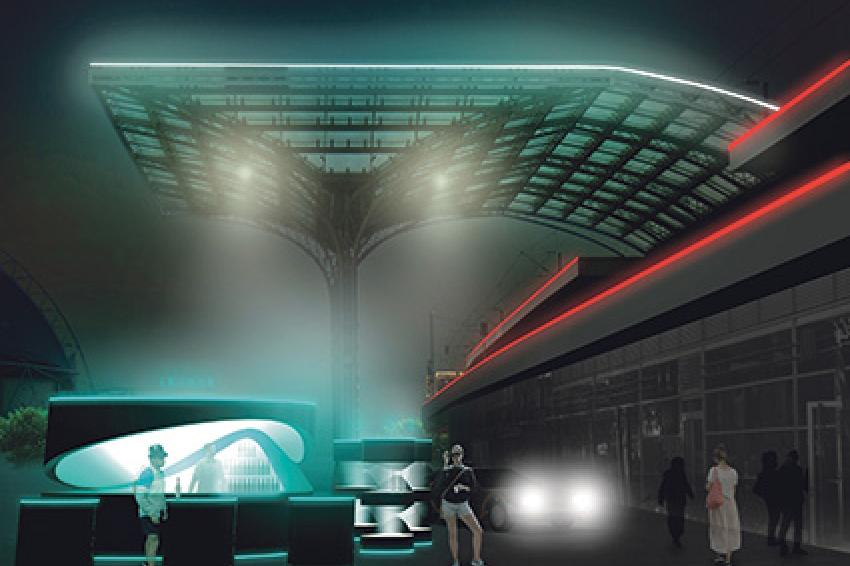Charging Stations in Cologne Could Become a Role Model for Energy Balance
30.01.2014 -
Sustaining Our Big Cities - More and more people across the globe are living in cities - a big challenge for the preservation of limited fossil fuels. High on the agenda is fostering alternative energy sources and raising efficiency in urban areas. There are already many single innovative technologies, but these must be combined to achieve comprehensive tailor-made solutions. Bayer MaterialScience and academic experts have created such a role-model concept for Cologne, Germany's fourth-largest city.
Urbanization - one of the major trends of our time. Today already more than half of the world's population consists of city residents, a proportion that is predicted to rise to roughly 70% by the middle of this century. In 1960 there were only two megacities in the world; in 2015 there will be more than 20. More inhabitants and more buildings mean more energy is needed for lighting, cooking, heating and cooling. Even now, buildings account for 40% of the global energy consumption and roughly one-third of the CO2 emissions.
All these are reasons enough to promote sustainable construction and city planning and to look for energy-efficient ideas and products. Policymakers have recognized this. For example, in the European Union, newly constructed buildings have to be so-called passive houses or zero-energy buildings from 2020. And Germany has introduced a funding program for retrofitting the millions of existing houses.
Both for old and new buildings, thermal insulation with rigid foams and other polymer materials is among the principal measures to reduce energy consumption for heating and cooling, thus limiting CO2 emissions and mitigating their climate effect.
Combining Polymers And Renewables
And there are lots of other high-performance products and solutions from the polymer industry that can support optimizing buildings energetically - from window frames to roof constructions and LED-based lighting systems. In combination with renewable sources such as photovoltaics, solar heat and geothermics, energy consumption can be considerably reduced.
What matters is an integrated approach that is far more effective than the sum of its parts. Construction experts across the world are already implementing this idea - for example, through the EcoCommercial Building Program (ECB), a multidisciplinary global network for the planning, design, integration and construction of low-impact buildings, founded and coordinated by Bayer MaterialScience.
"Of course there is a strong need for individual concepts for single buildings," said Eckard Foltin, head of the polymer company's "Creative Center," which is looking for future trends and material solutions. "But beyond that, total agglomerations can and must be energetically improved with the help of advanced materials and holistic thinking."
'Cologne Could Become Energy Neutral'
To furnish proof, Bayer MaterialScience joined forces with the Cologne University of Applied Sciences. Together they initiated the project "Cologne Clean City 2022" with the aim of demonstrating how this West German metropolis of one million inhabitants and a 2,000-year history can become energy neutral.
"By 2022, Cologne could have an equal energy balance," Foltin predicted.
That sounds ambitious given the fact that the city consumes huge amounts of energy while hardly storing any kilowatt-hours. Hence, the project partners analyzed the city districts and building structures to find locations that could be converted into energy storages or additional decentralized production units.
The challenge was to develop solutions that fit the city's character, history, given structure and individual architecture. They must not be perceived as alien elements.
"A wind turbine beside Cologne Cathedral wouldn't work," said Professor Jochen Siegemund, a chair of architecture at the University of Applied Sciences.
Private Cellars as Energy Stores
But the project partners succeeded in detecting suitable locations, for example, in the basements of houses close to the Rhine. Many of them are regularly flooded and cannot be used by the residents.
"However, they could be transferred into energy stores. Suppliers could install batteries there storing abundant electricity - let's say from wind power plants, which later could be called off and distributed if required," Foltin said.
The polymer industry could provide the right materials, such as special coatings to seal the cellars.
"Another example is high-performance plastics for the housings of smart grids, which are needed to transport the electricity to the batteries and from there into the households," Foltin added.
But the project partners came up with even more ideas.
"Why not make use of the many refreshment stands which are typical of Cologne and its sociable way of life?" Foltin said.
These "Büdchen" could be used as charging stations for electric cars while the driver has a break. Bayer MaterialScience provides special plastics for the charging stations' housings, which are flame-retardant and protect against vandalism.
Creating Awareness
However, all those ideas will not take off without acceptance and support from citizens, local politicians and companies such as energy providers as well as other stakeholders, as Siegemund emphasized: "So our central goal is to raise awareness and motivation. People should know that there is a need to make agglomerations like Cologne fit for a low-carbon society and a sustainable future. And they should learn that there are a lot of ways to achieve this."
The project partners hope that "Cologne Clean City 2022" can serve as a blueprint for many other cities, too. If the project grows not only by creating new intelligent energy systems supported by polymer solutions but also by influencing people's life and thinking, Cologne could become one of the first ecological cities in Europe.









